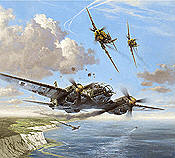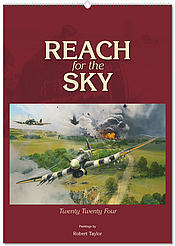Narrow Escape
Heinkel He-111 and Me-109E in the Battle of Britain
Description
The aviation art print 'Narrow Escape' by Heinz Krebs depicts a scene in the late summer of 1940, while the Battle of Britain is at its height. Racing for the coast, following a bombing mission over southern England, a straggling He111 of KG55 has been attacked by a Spitfire of RAF Fighter Command. The bomber is badly damaged, but in the nick of time a pair of Me109s of JG26 have come to the rescue. If they are lucky the Heinkel crew may still make it back to their base in France. On 7 September 1940, the first raid on London was launched, attacking docks in the East End of the city. During these massive raids on London the RAF airfields in Southern England remained largely undisturbed. This break from bombing the fighter bases gave the RAF critical breathing space. It was the turning point in the Battle of Britain. For the Luftwaffe, the most damaging aspect of the switch to London was the longer range. The Me 109 escorts had a limited fuel capacity, and this left many raids completely undefended by fighter escorts while being exposed to further attacks from additional RAF fighters based north of London. As in Heinz Krebs’ painting, the return from the bombing missions back to their bases across the English Channel often meant running the gauntlet for the German bomber crews. This crew obviously welcomes their rescuers from a desperate situation with distinct feelings of elation.
The Battle of Britain culminated on September 15, 1940 with two massive waves of German attacks that were decisively repulsed by the RAF. The German defeat caused Hitler to order the postponement of preparations for the invasion of Britain two days later. Henceforth, in the face of mounting losses in men, aircraft and the lack of adequate replacements, the Luftwaffe switched from daylight bombing raids to night-time attacks instead. The threat of invasion was essentially over although the German night blitz on London and other British cities continued into 1941.
The Battle of Britain culminated on September 15, 1940 with two massive waves of German attacks that were decisively repulsed by the RAF. The German defeat caused Hitler to order the postponement of preparations for the invasion of Britain two days later. Henceforth, in the face of mounting losses in men, aircraft and the lack of adequate replacements, the Luftwaffe switched from daylight bombing raids to night-time attacks instead. The threat of invasion was essentially over although the German night blitz on London and other British cities continued into 1941.
Printed on heavy stock acid-free paperand issued with a certificate of authenticity.
Limited Edition:
Limited Edition:
- 350 numbered copies, individually signed by the Artist and countersigned by five highly decorated German WWII Luftwaffe pilots, all of them recipients of Germany’s highest military award, the Knight’s Cross.
Signatories:
- Me-109 aces Hugo Dahmer and Otto Schultz
- He-111 pilots Hajo Herrmann, Heinrich Suedel and Hans Kirn
Overall Height ca.
67
cm
Overall Width ca.
69
cm







